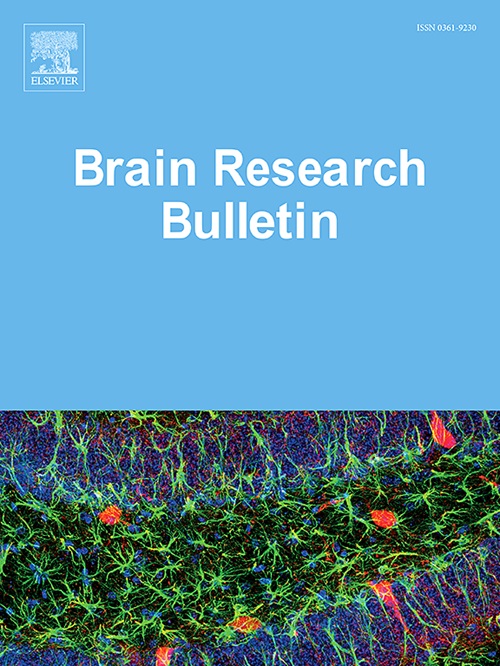Preventive effects of xanthohumol in APP/PS1 mice based on multi-omics atlas
IF 3.5
3区 医学
Q2 NEUROSCIENCES
引用次数: 0
Abstract
Alzheimer's disease (AD) is a complex disease with unknown etiology and pathogenesis. We described a combined analysis of murine proteomics and microbiomics to find potential therapeutic targets of different doses of xanthohumol (Xn), with the goal of providing a biological basis for the treatment of early AD. Xn improved the spatial learning and memory ability of APP/PS1 mice; this was associated with an increased number of newborn neurons in the subgranular zone (SGZ) and dentate gyrus (DG) and a decreased inflammatory response. 108 proteins were significantly changed after 0.5 mg/kg Xn treatment while only 72 proteins changed by 5 mg/kg Xn. Eight significant microbiota were modulated by different doses of Xn at line discriminant analysis (LDA) score 3.0, but only three of which were regulated by 0.5 mg/kg Xn at LDA score 4.0. In addition, Xn treatment could significantly regulate the pathways of neurodegeneration- multiple diseases in the hippocampus and the penicillin and cephalosporin biosynthesis and atrazine degradation pathways in the gut. Interestingly, Nefl protein validated by correlation analysis was found in the common signaling pathway. 0.5 mg/kg Xn was able to reverse the correlation between hippocampal proteins and gut microbiota. Xn treatment significantly improved cognitive function in AD transgenic mice. Different doses of Xn caused significant differences in protein expression and flora composition and abundance, suggesting that the doses of Xn should be selected with caution, and low dose may be better in the prevention of AD.
阿尔茨海默病(AD)是一种病因和发病机制不明的复杂疾病。我们对小鼠蛋白质组学和微生物组学进行了综合分析,以寻找不同剂量黄腐醇(Xn)的潜在治疗靶点,目的是为治疗早期阿尔茨海默病提供生物学基础。Xn改善了APP/PS1小鼠的空间学习和记忆能力;这与粒下区(SGZ)和齿状回(DG)新生神经元数量的增加以及炎症反应的减少有关。经 0.5 毫克/千克 Xn 处理后,108 种蛋白质发生了明显变化,而经 5 毫克/千克 Xn 处理后,仅 72 种蛋白质发生了变化。在线性判别分析(LDA)评分为 3.0 时,不同剂量的 Xn 可调节 8 个重要微生物群,但在 LDA 评分为 4.0 时,0.5 毫克/千克 Xn 只调节了其中 3 个微生物群。此外,Xn还能显著调节海马的神经变性-多种疾病通路,以及肠道的青霉素和头孢菌素生物合成和阿特拉津降解通路。有趣的是,通过相关性分析验证的 Nefl 蛋白被发现存在于共同的信号通路中。0.5 毫克/千克的 Xn 能够逆转海马蛋白与肠道微生物群之间的相关性。Xn治疗能明显改善AD转基因小鼠的认知功能。不同剂量的Xn会导致蛋白质表达、菌群组成和丰度的显著差异,这表明应谨慎选择Xn的剂量,低剂量可能更有利于预防AD。
本文章由计算机程序翻译,如有差异,请以英文原文为准。
求助全文
约1分钟内获得全文
求助全文
来源期刊

Brain Research Bulletin
医学-神经科学
CiteScore
6.90
自引率
2.60%
发文量
253
审稿时长
67 days
期刊介绍:
The Brain Research Bulletin (BRB) aims to publish novel work that advances our knowledge of molecular and cellular mechanisms that underlie neural network properties associated with behavior, cognition and other brain functions during neurodevelopment and in the adult. Although clinical research is out of the Journal''s scope, the BRB also aims to publish translation research that provides insight into biological mechanisms and processes associated with neurodegeneration mechanisms, neurological diseases and neuropsychiatric disorders. The Journal is especially interested in research using novel methodologies, such as optogenetics, multielectrode array recordings and life imaging in wild-type and genetically-modified animal models, with the goal to advance our understanding of how neurons, glia and networks function in vivo.
 求助内容:
求助内容: 应助结果提醒方式:
应助结果提醒方式:


